Bristlenose Pleco | A to Z Guide – Care, Tank Mates, Size and Diet

Table of Contents
Overview/Origin
With a weird, alien-like head, who will not recognize a bristlenose pleco in an instant? Small and bony-plated, this pleco fish is more distinct from the Common Pleco because they have smaller-framed bodies. The Bristlenose Pleco (also called Bushynose Catfish or Common Bristlenose Catfish) also came from the Ancistrus species, classifying them as suckermouths.
Appearance
There are various kinds of Pleco, and the Bristlenose Plecos are unique on their own! We have here outlined the body features that you can find distinct on them.
Bristlenose plecos have small-framed bodies, with wide heads. They look stout and fat than the Common Pleco. Their bodies are also protected with bony plates, which defend them from natural predators in the environment.
You may know a male pleco from a female one, by just looking at which ones have the sprout-like tentacles on its head. Males are more likely to have this feature and they have it longer than their counterparts.
These plecos are also suckerfishes, and their elongated lips aid them in eating algae. Their pectoral and abdominal fins are also more turned downward to ease their movements on surfaces.
You may see a bristlenose pleco in any slate colors of black, grey, or dark shades of olive and brown. Speckled on their bodies are also colors of white or yellow dots. With these body colors, they can easily camouflage in the tank substrate, and even in the dark parts of water!
Being known as a “master of disguise”, they are also not so active in swimming, making your aquarium look empty of them!
Behaviour & Temperament
If your interest is to keep more peaceful tank fishes, then the bristlenose pleco will be a very great addition for the rest of your tank community! This suckermouth fish is a compatible companion for most peaceful aquarium fishes, too.
Their kind also stays most of the time in the bottom of the tank. Making them a perfect match for other fishes that love swimming in the middle part of the waters. Calm fishes that tend to show off can be included as well to create more activity compared to the less active plecos.
Although the plecos have very pleasant behaviors, you should not take in two or more male types of them to the same tank. Male plecos can be extra aggressive to each other and might even do so with other male species.
They can be territorial and be dangerous for the surrounding fishes too as they have armor-like bodies. The males’ tentacles may even tangle with each other! It is best to keep more female plecos to reduce such risky behavior in the tank.
You should also know that adult plecos may not easily mingle in the community tank. So if you would be housing these kinds of plecos, bear in mind to have regular monitoring on them or better yet buy a larger tank.
Lifespan
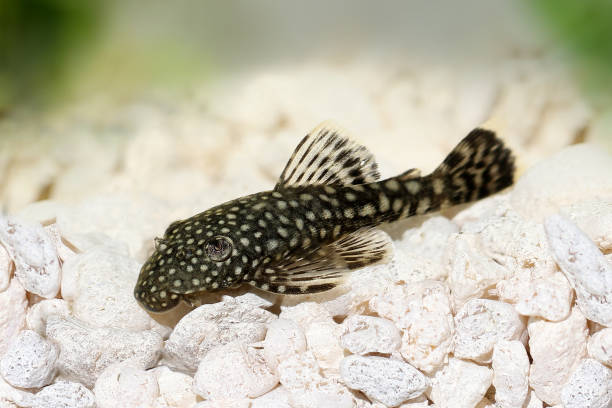
How long does Bristlenose Pleco live?
Compared to other tank fishes, Bristlenose Plecos may not be as active and aesthetic in the eye. But when it comes to the length of their lifespan, you might get surprised that they are one of the most investment-worthy fishes for your tank!
If they are given a well-maintained habitat and that all tank requirements are met, the cleaner fish can reach a lifespan of 5 years.
With even more proper care and healthy feeding, there are even owners that claim these fishes can live for up to 10-15 years! With that, anybody can agree that it is some hardy, sustainable fish to keep.
Common Diseases
Bristlenose pleco is a hardy fish that with proper care can outlive most small fish species. Though they do not have diseases related to their kind, it does not mean that they are not vulnerable to other fish diseases.
With good tank management, the fish can thrive for years and not fail to impress the owner with its tank behavior, and towards other fishes. It should be important that constant monitoring of water quality is at the top of your list. Doing so ensures that the fish’s health is not compromised all the time.
As an owner, you should be able to detect easily any changes in the fish (e.g., behavior) to prevent any ailments. As these fishes will be in captivity, you will be needing to pay more attention to any problem that may arise in their new abode.
Ich
You might have heard already about the common fish bouts with ich. It is one of those illnesses that are considered to be both common and fatal for any aquarium fish.
Ich is a disease of small, white spots covering the fish’s body. The condition makes the fish want to scratch its body on surfaces to relieve the itchy feeling. A popular reason why a tank fish can have this illness is due to the tank water’s low or poor quality.
If you see that one of your fishes is suffering from ich, the best thing to do is to place it in an isolated tank away from the others. Remember that it is contagious and can even affect a whole tank of fish if left unattended!
Compared to the main tank, the affected fish as being placed in a quarantine container will need a bit higher temperature to eliminate the protozoa causing the disease.
Dropsy
Another name for Malawi bloat. Dropsy is also a disease that can make your pleco fishes sick. The illness is described as a bloating problem that can also cause changes in the fish’s skin color.
Replacing the tank water at regular times helps reduce the possibility of dropsy from happening. It is advisable to change twenty-five percent of the tank water every week to get the optimal quality of standard water for your fish!
You may also need to put extra focus on the stuff you feed to the plecos. For example, giving them more high-quality food and combining it with proper medication is superb for the fish’s health!
Fin rot
Your fish may also suffer from fin rot caused by either poor quality of water or the possibility of other fishes biting the fins of your pleco. The illness makes the fish swim slower in its torn fins and might even eat less than the other fishes.
To minimize the disease from happening it is best to maintain a clean environment for the fish and not including many aggressive fishes in the tank, too.
If you suspect that the disease is due to poor water quality, you may try to use tetracycline. Tetracycline can aid in bacterial infections that happen in freshwater aquariums.
Pop-eye
Just as it sounds, pop-eye is what is called for a fish that is suffering from protruding eyes. Although this is curable, having tetracycline handy all the time can help your plecos from contracting the disease.
To treat the disease, again water standards must be well-administered. Also for their healthy diet, foods enriched with vitamins are still a number one rule.
Fish Fungi
Water that is not well-tended can also be breeding grounds for fish fungus. The water molds, also called oomycetes, are said to cause the dreaded condition. Fungi multiply fast especially if the water stays unreplaced or not par to the required aquarium temperature.
Size
How big do Bristlenose Pleco get?
The Bristlenose Pleco fish deserves a spot in one of the small but excellent freshwater fishes for aesthetic aquariums! Because why not? For their maximum growth size of 4 to 5 inches, they can surpass the lifespan of most best-selling small fishes in the trade!
These small-sized plecos are able to get through the nooks and crannies of the tank and are not much of a bother even if mixed with other small fishes. Their height and length make them look like bottom-dwellers (and because they really are!).
With their small frames, you might want to let other active, small fishes in their company, enlivening your aquarium!

How many Bristlenose Pleco can be kept together?
For each fish, you can maintain at least 10 gallons of water for them to live comfortably. This makes a 20-gallon tank able to handle 2-3 plecos only.
It is advisable to watch out for the number of males when filling up a tank. Though these species are known to be peaceful and calm creatures, the male types can show aggression towards their male kin too.
You can avoid this occurrence by getting more females, especially if you are planning to keep more than three of their kind.
Bristlenose Pleco Care
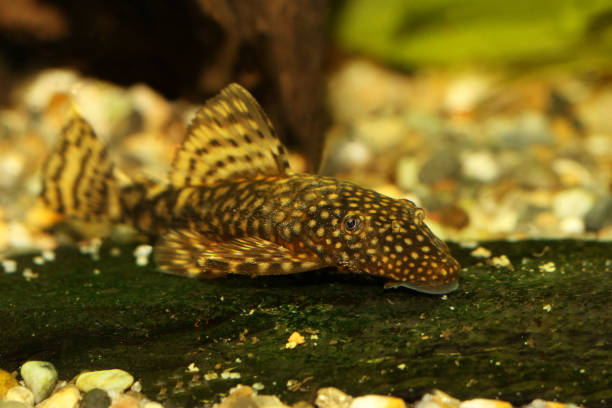
Tank Size
Bristlenoses are one of the best freshwater species for fish keepers that are beginning with the hobby. Their tank requirements are almost the same with easy-to-keep fishes.
A tank that can handle at least 20-30 gallons is enough, but adding more liters is still advisable to give a more comfortable biome for the fish.
Remember that, this kind of fish also needs a large water capacity as they excrete waste more than other tank fishes. With that in mind, you are to watch the ammonium content of their water from time to time.
An ammonia build-up is much faster, too, in smaller water tanks. That is why it is necessary to choose the right tank to cater to the fish behavior before you begin the whole tank setup.
Tank Setup
A tank that can handle a minimum of 25 gallons is ideal for the plecos. If you got a bigger tank the better! Fulfill the fish’s algae needs too by placing driftwoods and some hiding places. Plants or decorations are essential as the plecos love staying in well-shaded places.
Things such as the tank temperature can easily be adjusted by using a water heater. Keeping one handy is efficient and will even help you save time.
If you also own young plecos, mind that they are sensitive to temperature and light changes. You can also decide to place them in a different tank for them to thrive on water parameters more suitable to them.
Water conditions
Though this type of catfish is hardy and can live under a variety of water conditions, its owner must pay close attention with the tank maintenance. Aim to have a closely replicated environment from the species’ natural habitat. A priority on the list is the water provided throughout their stay in the tank.
The following are the standards that are widely used for the maintenance of the pleco’s aquatic abode:
- Water pH level: The fish thrives in a slightly acidic water abode. Try to have at least an average of 6.5 to 7.5 pH levels in the tank even in every water replacement. Note: Drastic temperature changes may lead the fishes to contract infections or diseases if not monitored correctly.
- Water hardness: pertains to the mineral content of the tank water. For the Pleco fish, keep an average of 6 to 10 KH as these ranges resemble the closest to the place they originated. Giving the best water condition enables the fish to have healthy survival and guaranteed longevity.
- Water Temperature: You may need the aid of a water heater to make sure that heat is well-dispersed in all corners of the tank. For the catfish, there should be a sustained range of about 60 to 80 degrees Fahrenheit on the surrounding water.
Diet & Feeding
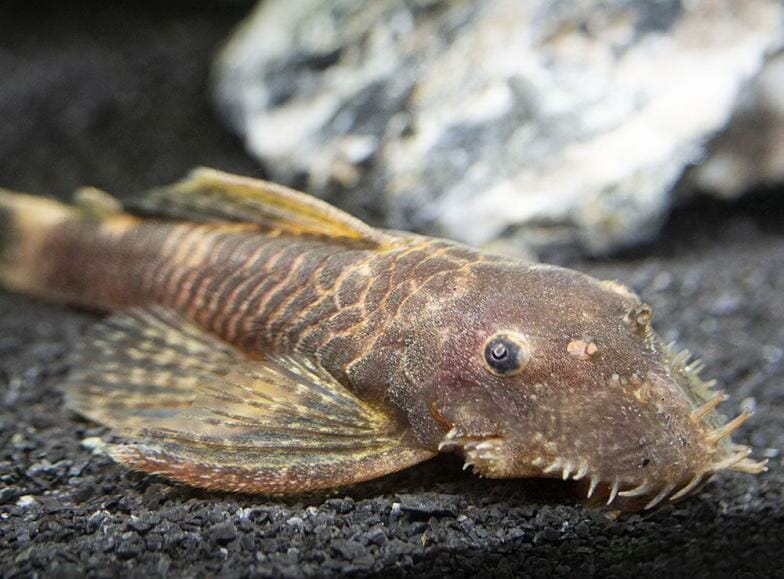
What do Bristlenose Pleco eat?
Bristlenose Plecos are natural algae-eaters. They are even well-known for being able to make tank corners clean from algae build-up!
Driftwood can be essential for their biome as it helps with algae growth. Having one around will leave them fed even if you are out of the house for days.
As herbivores, you can also feed them spirulina wafers or blanched vegetables. These fish foods include, but are not limited to peas, cucumbers, or carrots.
Protein must be included for their more balanced diet, too. Nutritive foods such as those of flakes, and bloodworms are still a hit for tank fishes. For occasional days, serve some treats too like zucchini slices and romaine lettuce, as their content boosts fish health.
They love staying on the substrate, too. That is why you should also keep a supply of food pellets that are deemed best for bottom-dwellers.
When plecos are well-fed, you will be able to observe their skin colors to be brighter rather than dull and flushed. Overfeeding the fish is not advisable as doing so increases the ammonium rate inside the tank.
Excess food once spoiled can cause health risks not only to the catfish but also to the other fish members in your tank! Try to maintain a cleaner tank by removing the remaining food every 2-3 hours after their eating.
How often should I feed my Bristlenose Pleco?
Feeding the fish one to three times a day is necessary to fulfill its nutritional needs. Regular feeding maintains their everyday appetite and sustains their skin coloration to vividness.
It is best to keep a fixed schedule for the feeding time so you can prevent overfeeding. Doing this reduces spoiled food from increasing ammonia in the tank.
Fish pellets that have plant-based material can also be given to the fish from time to time. But sticking to natural fish foods is the most excellent for their everyday meal.
How long can Bristlenose Pleco go without food?
As herbivores, plecos consume more plant-based food. But such appetite has low-calorie content making them starve faster than carnivorous fishes. Like any other tropical fish, these plecos can thrive for an average of 2-3 days without food. For adult plecos, they can even be left for a week without being fed.
In the case that you have to leave the fish for a couple of days, it would be beneficial if there are edible plants inside the tank. You may also try adjusting the tank light to a more dim time to reduce their need for food.
Instead of 12 hours, set the timer to only 6 hours of light activity. This task makes the fish consume slower on their food, and even move less. Aim for your fish to have lower activity too if you do not have much time monitoring them during the day.
Tank Mates
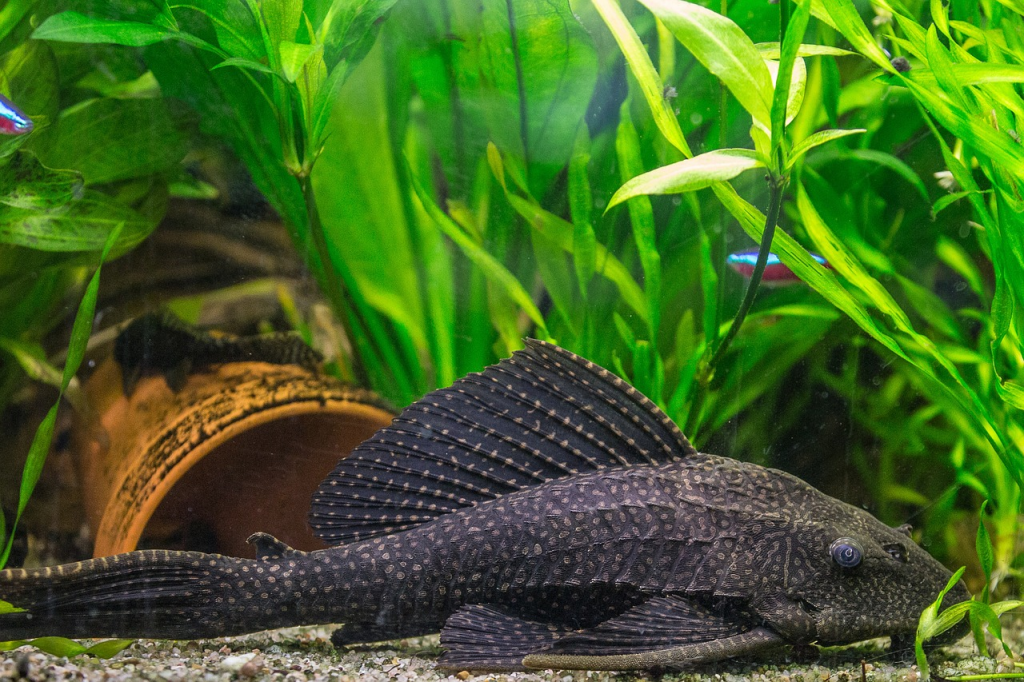
What fish can live with Bristlenose Pleco?
If you are deciding to keep more than one pleco fish, always remember that the lesser the males in the tank, the better. As explained in the prior topics, males tend to be more aggressive to each other and they can even manifest these with other male species.
There are also cases where these pleco fish (having well-protected bodies) are placed in tanks with beautiful, finned fishes with aggressive tendencies (the bettas, or cichlids). Although accompanying the pleco with aggressive ones is possible, this is not always recommendable. The situation could still cause a stressful environment for the fish if tried to be attacked by the aggressive one.
It is still best to stick first to the following tank mates for your pleco if you are still beginning with fishkeeping:
- Neon Tetras
- Guppies
- Platy Fish
- Tiger Barbs
- Gouramis
- Zebra Danios
What fish don’t do well with Bristlenose Pleco?
The suckermouth catfish is undeniably one of the most compatible tank fishes for the aquarium. They even go well in tanks with schools of other peaceful fishes!
With this said, note that joining the pleco with other fishes would still require some pointers to follow. One of these is the size differences. Fishes that are smaller than the plecos, can be easily mistaken as a feed instead.
Axolotls will not do well too around the plecos. With delicate bodies, they might not be safe around the fish that is covered in spines.
Other aquarium creatures such as the shrimps, can easily be seen as food for the pleco. A tip to looking for a good tank companion is if the fish can fit in the mouth of the pleco then it’s not a suitable tank mate at all!
In looking for tank mates for your pleco, having more fish that stay most of the time at the middle to the top layer of the aquarium will be an excellent choice.
Breeding
If you like to breed the plecos, they can do this on their own too. Any regular tank for the pleco is already enough as a breeding place. All you have to do is to provide a conducive environment for the spawning to take place.
To set up the habitat of the Bristlenose plecos, make sure that there are good dwelling places for the males such as driftwoods and caves. Once they get to be adults they will frequent those areas like checking if they are already excellent for the spawning process.
Naturally, the plecos breed during their mating season. Female plecos will lay eggs on the designated areas of the male adult plecos that will stand guard afterward.
Females will be sticking out their eggs on the cave or any surface that the male has provided them. Sometimes they lay on driftwoods where algae growth happens spontaneously.
Males will keep the territory safe from other fish intruders. It will do so for two weeks or more, up until the eggs have hatched. The egg yolk will be soaked up by the fry for days, but when done will immediately start to look for food.
Summary
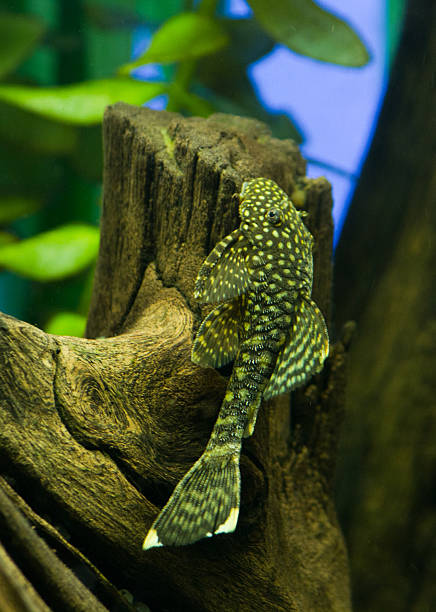
Are Bristlenose Pleco easy to care for?
Though they are not as aesthetic-looking as the other aquarium fishes that you may see in the pet shop, the plecos are sure to grant you years of effortless caring for them. They never fail to be great tank mates for any peaceful fish that you have in the tank community.
Planning to populate your aquarium? No worries! Plecos are excellent to get along with other fish species too as long as there are enough areas for them to dwell on.
Plecos are best around small, peaceful fishes. Only beware of including those that can fit the mouth of the pleco fish, or else they might end up being eaten instead!